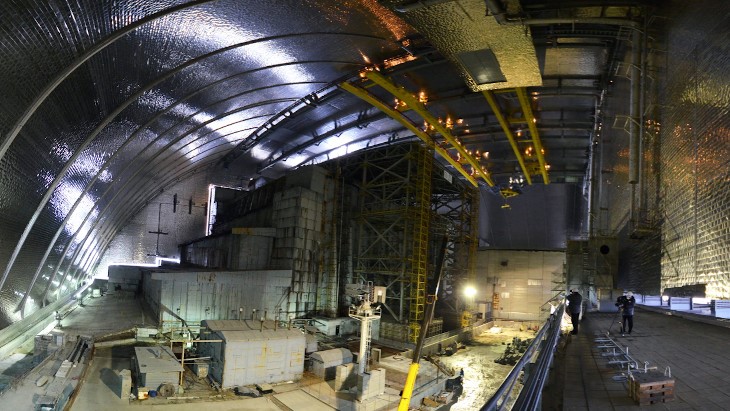Chernobyl waste facility nears operation
Final testing is underway at the facility which will receive, process and dispose of solid radioactive waste from the decommissioning of Chernobyl. "This is a very important event," said the acting director general of Chernobyl nuclear power plant, Valery Seyda. "The last 'long-term construction' at the site is finally moving towards completion."

Chernobyl 4 will be dismantled remotely within the New Safe Confinement with the resulting wastes handled by the new facility (Image: Chernobyl NPP)
"From now we will fully work in all directions: with fuel, liquid waste, and with solid waste," said Seyda.
The forthcoming facility is officially known as the Industrial Complex for the Solid Radioactive Waste Management (ICSRM). It will process and store some wastes already present at the site, as well as wastes from the dismantling of unit 4, which will take place under the New Safe Confinement structure.
The final stage of 'hot testing' began yesterday, Chernobyl NPP announced, explaining it will be working with real radioactive materials under conditions as close to future operation as possible.
The ICSRM comprises four facilities. 'Lot 0' is temporary storage for low- and intermediate-level long-lived waste as well as high-level waste. This is within the Liquid and Solid Waste Storage Facility and was commissioned in 2010.
'Lot 1' will retrieve solid wastes from an existing solid waste storage facility. It will handle 3 cubic metres of waste per day over an operational life of 30 years.
'Lot 2' will sort solid wastes and process low- and intermediate-level wastes at the rate of 20 cubic metres per day. Some solid and liquid wastes will be incinerated, and some will be cemented. It can package 1.5 cubic metres of low- and intermediate-level long-lived waste per day, and can store 3500 cubic metres of them and high-level waste.
'Lot 3' is a near-surface storage facility for low- and intermediate-level short-lived waste with a capacity of 55,000 cubic metres. It will accept waste for 30 years and store it for 300 years.
The facility has been in commissioning since May 2014.
Researched and written by World Nuclear News
- China Institute of Atomic Energy
- Nuclear Power Institute of China
- Southwestern Institute of Physics
- China Nuclear Power Operation Technology Corporation, Ltd.
- China Nuclear Power Engineering Co., Ltd.
- China Institute for Radiation Protection
- Beijing Research Institute of Uranium Geology (BRIUG)
- China Institute of Nuclear Industry Strategy (CINIS)
- China Nuclear Mining Science and Technology Corporation


